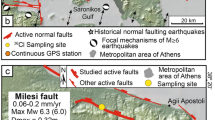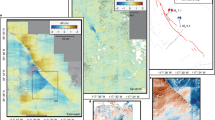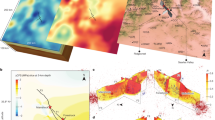Abstract
The San Andreas Fault System, one of the best-studied transform plate boundaries on Earth, is well known for its complex network of locked faults that slowly deform the crust in response to large-scale plate motions1,2,3,4,5,6,7,8. Horizontal interseismic motions of the fault system are largely predictable, but vertical motions arising from tectonic sources remain enigmatic. Here we show that when carefully treated for spatial consistency, global positioning system-derived vertical velocities expose a small-amplitude (±2 mm yr−1), but spatially considerable (200 km), coherent pattern of uplift and subsidence straddling the fault system in southern California. We employ the statistical method of model selection to isolate this vertical velocity field from non-tectonic signals that induce velocity variations in both magnitude and direction across small distances (less than tens of kilometres; ref. 9), and find remarkable agreement with the sense of vertical motions predicted by physical earthquake cycle models spanning the past few centuries6,10. We suggest that these motions reveal the subtle, but identifiable, tectonic fingerprint of far-field flexure due to more than 300 years of fault locking and creeping depth variability. Understanding this critical component of interseismic deformation at a complex strike–slip plate boundary will better constrain regional mechanics and crustal rheology, improving the quantification of seismic hazards in southern California and beyond.
This is a preview of subscription content, access via your institution
Access options
Subscribe to this journal
Receive 12 print issues and online access
$259.00 per year
only $21.58 per issue
Buy this article
- Purchase on Springer Link
- Instant access to full article PDF
Prices may be subject to local taxes which are calculated during checkout




Similar content being viewed by others
References
Massonnet, D. et al. The displacement field of the Landers earthquake mapped by radar interferometry. Nature 364, 138–142 (1993).
Deng, J., Gurnis, M., Kanamori, H. & Hauksson, E. Viscoelastic flow in the lower crust after the 1992 Landers, California, earthquake. Science 282, 1689–1692 (1998).
Fialko, Y., Simons, M. & Agnew, D. The complete (3-D) surface displacement field in the epicentral area of the 1999 Mw7.1 Hector Mine earthquake, California, from space geodetic observations. Geophys. Res. Lett. 28, 3063–3066 (2001).
Pollitz, F. F., Wicks, C. & Thatcher, W. Mantle flow beneath a continental strike–slip fault: postseismic deformation after the 1999 Hector Mine earthquake. Science 293, 1814–1818 (2001).
Johnson, K. M. & Segall, P. Viscoelastic earthquake cycle models with deep stress-driven creep along the San Andreas Fault System. J. Geophys. Res. 109, B10403 (2004).
Smith-Konter, B. & Sandwell, D. T. A model of the earthquake cycle along the San Andreas Fault System for the past 1000 years. J. Geophys. Res. 111, B01405 (2006).
Tong, X., Sandwell, D. T. & Smith-Konter, B. High-resolution interseismic velocity data along the San Andreas Fault from GPS and InSAR. J. Geophys. Res. 118, 369–389 (2013).
Smith-Konter, B. R., Thornton, G. M. & Sandwell, D. T. Vertical crustal displacement due to interseismic deformation along the San Andreas Fault: constraints from tide gauges. Geophys. Res. Lett. 41, 3793–3801 (2014).
Blume, F. et al. Stability of GNSS Monumentation: Analysis of Co-Located Monuments in the Plate Boundary Observatory Fall Meeting 9–13 December, abstract number G51B-04 (American Geophysical Union, 2013).
Smith, B. & Sandwell, D. T. A 3-D semi-analytic viscoelastic model for time-dependent analyses of the earthquake cycle. J. Geophys. Res. 109, B12401 (2004).
Tong, X., Smith-Konter, B. & Sandwell, D. T. Is there a discrepancy between geological and geodetic slip rates along the San Andreas Fault System? J. Geophys. Res. 119, 2518–2538 (2014).
Hetland, E. A. & Hager, B. H. Postseismic and interseismic displacements near a strike–slip fault: a two-dimensional theory for general linear viscoelastic rheologies. J. Geophys. Res. 110, B10401 (2005).
Melini, D. et al. Earthquakes and relative sea level changes. Geophys. Res. Lett. 31, L09601 (2004).
Sieh, K. et al. Earthquake supercycles inferred from sea-level changes recorded in the corals of West Sumatra. Science 322, 1674–1678 (2008).
Amos, C. B. et al. Uplift and seismicity driven by groundwater depletion in central California. Nature 509, 483–486 (2014).
Argus, D. F., Fu, Y. & Landerer, F. W. Seasonal variation in total water storage in California inferred from GPS observations of vertical land motion. Geophys. Res. Lett. 41, 1971–1980 (2014).
Borsa, A. A., Agnew, D. C. & Cayan, D. R. Ongoing drought-induced uplift in the western United States. Science 345, 1587–1590 (2014).
EarthScope Plate Boundary Observatory (UNAVCO, accessed January 2015); http://pbo.unavco.org/data/gps
Burnham, K. P. & Anderson, D. R. Model Selection and Multimodel Inference: A Practical Information-Theoretic Approach 2nd edn (Springer, 2002).
Burnham, K. P. & Anderson, D. R. Multimodel inference: understanding AIC and BIC in model selection. Sociol. Methods Res. 33, 261–304 (2004).
MATLAB Statistics Toolbox Release 2014b (The MathWorks, 2014).
Wessel, P. A general-purpose Green’s function-based interpolator. Comput. Geosci. 35, 1247–1254 (2009).
Freed, A. M. & Burgmann, R. Evidence of power-law flow in the Mojave Desert mantle. Nature 430, 548–551 (2004).
Moore, D. E. & Rymer, M. J. Talc-bearing serpentinite and the creeping section of the San Andreas Fault. Nature 448, 795–797 (2007).
Lyons, S. N., Bock, Y. & Sandwell, D. T. Creep along the Imperial Fault, southern California, from GPS measurements. J. Geophys. Res. 107, 2249 (2002).
Sandwell, D. T. et al. Investigations into Effects of Different Modeling Codes and Rheology on Predicted Coseismic and Postseismic Surface Deformation Annual Meeting 8-12 September, Tectonic Geodesy Poster 239 (Southern California Earthquake Center, 2012).
Conrad, C. P. The solid Earth’s influence on sea level. Geol. Soc. Am. Bull. 125, 1027–1052 (2013).
Peltier, W. R. Global sea level rise and glacial isostatic adjustment. Glob. Planet. Change 20, 93–12 (1999).
Tong, X., Sandwell, D. & Smith-Konter, B. An integral method to estimating the moment accumulation rate on the creeping section of the San Andreas Fault. Geophys. J. Int. 203, 48–62 (2015).
Akaike, H. A new look at the statistical model identification. IEEE Trans Automat. Control 19, 716–723 (1974).
Gelman, A. et al. Bayesian Data Analysis 3rd edn, 356–360 (Chapman and Hall/CRC, 2014).
Steketee, J. A. On Volterra’s dislocations in a semi-infinite elastic medium. Can. J. Phys. 36, 192–205 (1958).
Smith, B. & Sandwell, D. Coulomb stress accumulation along the San Andreas Fault System. J. Geophys. Res. 108, 2296 (2003).
Boussinesq, J. Application des Potentiels a l’Etude de l’Equilibre et du Mouvement des Solides Elastiques 508 (Gauthier-Viallars, 1885).
Burmister, D. M. The theory of stresses and displacements in layered systems and applications of the design of airport runways. Proc. Highway Res. Board 23, 126–148 (1943).
Weertman, J. Continuum distribution of dislocations on faults with finite friction. Bull. Seismol. Soc. Am. 54, 1035–1058 (1964).
Rundle, J. B. & Jackson, D. D. A three-dimensional viscoelastic model of a strike slip fault. Geophys. J. R. Astron. Soc. 49, 575–591 (1977).
Fay, N. P. & Humphreys, E. D. Fault slip rates, effects of elastic heterogeneity on geodetic data, and the strength of the lower crust in the Salton Trough region, southern California. J. Geophys. Res. 110, B09401 (2005).
Pollitz, F. F. Transient rheology of the uppermost mantle beneath the Mojave Desert, California. Earth Planet. Sci. Lett. 215, 89–104 (2003).
Pollitz, F. F. Transient rheology of the upper mantle beneath central Alaska inferred from the crustal velocity field following the 2002 Denali earthquake. J. Geophys. Res. 110, B08407 (2005).
Hearn, E. H., McClusky, S., Ergintav, S. & Reilinger, R. E. Izmit earthquake postseismic deformation and dynamics of the North Anatolian Fault Zone. J. Geophys. Res. 114, B08405 (2009).
Panet, I. et al. Upper mantle rheology from GRACE and GPS postseismic deformation after the 2004 Sumatra-Andaman earthquake. Geochem. Geophys. Geosyst. 11, Q06008 (2010).
2007 Working Group on California Earthquake Probabilities The Uniform California Earthquake Rupture Forecast, Version 2 (UCERF) USGS Open File Report 2007-1437, CGS Special Report 203 (US Geological Survey, 2008).
Savage, J. C. Equivalent strike–slip earthquake cycles in half-space and lithosphere-asthenosphere earth models. J. Geophys. Res. 95, 4873–4879 (1990).
Meade, B. J. & Hager, B. H. Viscoelastic deformation for a clustered earthquake cycle. Geophys. Res. Lett. 31, L10610 (2004).
Savage, J. C. Dislocation pileup as a representation of strain accumulation on a strike–slip fault. J. Geophys. Res. 111, B04405 (2006).
Richards-Dinger, K. B. & Shearer, P. M. Earthquake locations in southern California obtained using source-specific station terms. J. Geophys. Res. 105, 10939–10960 (2000).
Smith-Konter, B., Sandwell, D. T. & Shearer, P. Locking depths estimated from geodesy and seismology along the San Andreas Fault System: implications for seismic moment release. J. Geophys. Res. 116, B06401 (2011).
Williams, C. A. & Richardson, R. M. A rheologically layered three-dimensional model of the San Andreas Fault in central and southern California. J. Geophys. Res. 96, 16597–16623 (1991).
Wdowinski, S., Smith-Konter, B., Bock, Y. & Sandwell, D. T. Diffuse interseismic deformation across the Pacific–North America plate boundary. Geology 35, 311–314 (2007).
Acknowledgements
We thank P. Wessel and J. Foster for their preliminary review of this manuscript, J. Foster for clarifying sources of data noise, and G. Thornton for his initial modelling efforts that contributed to this work. This study was supported by National Science Foundation grants EAR-0838252 and EAR-1424374. This material is based on data provided by the Plate Boundary Observatory operated by UNAVCO for EarthScope (www.earthscope.org) and supported by the National Science Foundation No. EAR-0350028 and EAR-0732947.
Author information
Authors and Affiliations
Contributions
S.H. performed the statistical GPS data analysis and comparisons between statistical and physical models, prepared figures, and wrote the paper. B.S.-K. produced vertical velocity field for physical numerical models. N.F. offered guidance on the statistical methods. B.S.-K. and X.T. identified spurious GPS data using InSAR. D.S. offered guidance on regional geology and deformation, as well as the scope and presentation of the study. All authors discussed the study results and improved the manuscript.
Corresponding author
Ethics declarations
Competing interests
The authors declare no competing financial interests.
Supplementary information
Supplementary Information
Supplementary Information (PDF 957 kb)
Rights and permissions
About this article
Cite this article
Howell, S., Smith-Konter, B., Frazer, N. et al. The vertical fingerprint of earthquake cycle loading in southern California. Nature Geosci 9, 611–614 (2016). https://doi.org/10.1038/ngeo2741
Received:
Accepted:
Published:
Issue Date:
DOI: https://doi.org/10.1038/ngeo2741
This article is cited by
-
Joint adjustment for large-area, multi-source vertical data: method, validation and application
Acta Geodaetica et Geophysica (2021)
-
Dynamic flood modeling essential to assess the coastal impacts of climate change
Scientific Reports (2019)



